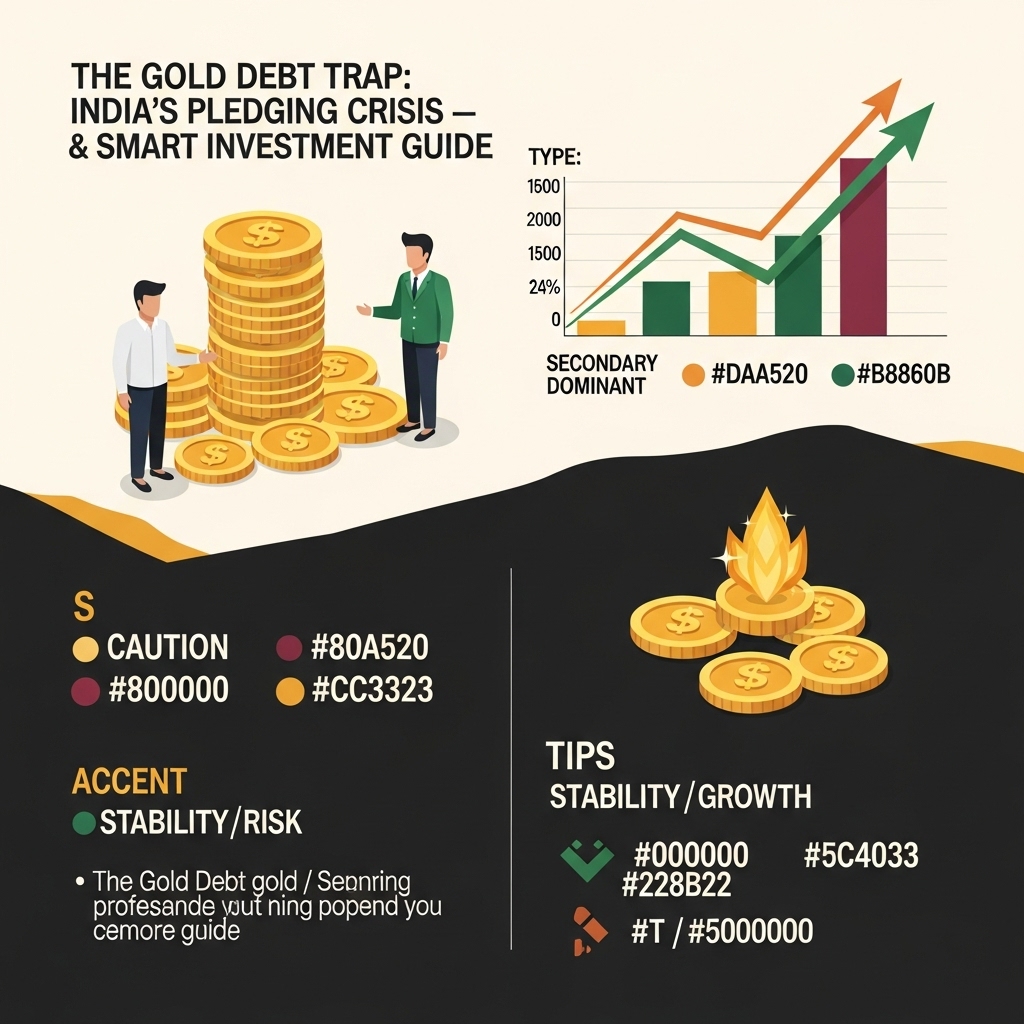The Golden Handcuff: Why India’s Gold Pledge Surge Matters for Investors
Gold, the quintessential safe haven, has once again proven its mettle, with prices recently scaling unprecedented heights and reinforcing its appeal as a cornerstone for portfolio diversification. For savvy gold investors, monitoring market trends is paramount, and few trends are as intriguing—and concerning—as the current landscape in India. A nation globally renowned for its deep-rooted cultural affinity and insatiable demand for gold, India is now grappling with a paradoxical financial challenge: a surge in gold pledging to record levels, accompanied by a worrying uptick in loan default rates.
This section delves deep into the heart of this complex issue, exploring the multifaceted reasons behind why millions of Indians are increasingly turning to their most cherished asset for liquidity, even as its market value soars. We will dissect the socio-economic pressures, shifting financial behaviors, and the intricate market dynamics contributing to this phenomenon. For gold investors, understanding these nuanced financial benefits and risks is not just academic; it offers critical insights into global gold demand drivers, potential market volatility, and the broader economic health of a major consumer. Prepare to uncover the hidden story behind India’s golden paradox and its implications for the future of gold investing.
Gold Market Analysis and Key Insights
India’s intricate relationship with gold extends far beyond its cultural significance, positioning it as a crucial investment vehicle and a primary financial fallback for millions. The recent surge in gold pledging and defaults underscores its dual role as a prized asset and a potential distress-driven liquidity source.
Key Market Insights
Gold as a Strategic Asset
For many Indian households, especially in rural areas lacking formal credit access, gold serves as the most accessible form of collateral and a store of generational wealth. It acts as an informal financial safety net, easily convertible into cash through pledging during emergencies or for business capital, highlighting its unparalleled liquidity in times of need.
Inflationary Hedge and Safe Haven
Globally, gold is traditionally seen as a hedge against inflation and economic uncertainty. In periods of high inflation or currency depreciation, investors often flock to gold to preserve purchasing power. This perception is particularly strong in India, where economic fluctuations can disproportionately impact savings, making gold a seemingly secure alternative to conventional financial instruments.
Liquidity and Risk Nexus
While gold’s liquidity is a clear benefit, the rising default rates on gold loans reveal a critical underlying issue: over-reliance on this asset. When economic hardships compel individuals to pledge their gold, the asset’s inherent value is leveraged against a loan, introducing interest costs and the risk of forfeiture if repayment fails, transforming a stable asset into a volatile liability.
Current Gold Market Trends and Data
The global gold market has seen significant upward movement, with prices reaching historic highs driven by geopolitical tensions, inflationary pressures, and fluctuating interest rates. This appreciation initially boosted the value of pledged gold, allowing for larger loan amounts. However, any subsequent price corrections or persistent economic strain can quickly erode this buffer, making loan repayment challenging. India, as one of the world’s largest gold consumers, directly influences global demand and price stability, with domestic price movements often reflecting international trends and the Rupee’s strength.
Investment Benefits and Considerations
Gold offers several benefits: it’s a reliable store of value, an effective portfolio diversifier, and a tangible asset offering protection against economic downturns. However, investors must consider its price volatility, the security and insurance costs associated with physical gold, and its relatively low yield compared to equity or debt instruments. For those contemplating pledging, the immediate liquidity comes with the significant consideration of interest rates and the risk of losing the asset.
Expert Recommendations
Financial advisors advocate for a balanced portfolio, suggesting a modest allocation to gold (typically 5-15%) primarily for diversification and long-term wealth preservation, rather than speculative gains. They caution against over-leveraging gold assets through pledging, especially for non-essential needs, to mitigate the risk of default. Understanding the terms of any gold loan is paramount, and exploring alternative financial instruments for liquidity should be a priority before resorting to pledging.

Gold Investment Strategies and Options
For many Indians, gold represents not just cultural heritage but also a perceived safe-haven investment. However, widespread reliance on pledging physical gold points to a lack of awareness regarding modern, often safer, investment alternatives. Understanding these options is crucial for effective wealth management beyond traditional physical assets.
Different Gold Investment Options and Strategies:
* Physical Gold: Jewelry, coins, and bars offer tangible ownership but involve storage risks, insurance costs, and making charges that erode value upon resale.
* Gold Exchange Traded Funds (ETFs): These digital instruments track domestic gold prices, offering liquidity and eliminating storage concerns. They are ideal for investors seeking exposure to gold prices without physical possession.
* Sovereign Gold Bonds (SGBs): Issued by the RBI, SGBs are gold-denominated bonds offering annual interest (currently 2.50%) and capital gains tax exemption on maturity (after 8 years), making them highly attractive for long-term investors.
* Gold Mutual Funds: These schemes invest in gold ETFs or companies involved in gold mining, providing professional management and diversification, albeit with an expense ratio.
* Digital Gold: Online platforms allow purchasing 24K gold in small denominations, which is stored in vaults by the provider.
Risk Assessment and Portfolio Allocation:
Gold serves as a hedge against inflation and economic uncertainty, diversifying a broader investment portfolio. Financial advisors typically recommend allocating 5-15% of a portfolio to gold, viewing it as a wealth preservation asset rather than a primary growth engine. While gold generally offers stability, its prices can still fluctuate due to global economic data, interest rates, and geopolitical events. Liquidity also varies; physical gold is generally less liquid than digital or bond options.
Comparison of Investment Methods:
Physical gold, while culturally significant, lacks the liquidity and security of its digital counterparts. Gold ETFs provide price tracking and convenience. SGBs stand out for their interest income, tax benefits, and government backing, making them a superior choice for long-term holdings. Digital Gold facilitates easy, small-scale purchases suitable for systematic investments.
Market Timing Considerations:
Gold should primarily be viewed as a long-term strategic asset. Attempting to time the market for short-term gains is risky due to price volatility. A better strategy involves accumulating gold during market dips or through Systematic Investment Plans (SIPs) in gold ETFs or Digital Gold, which helps average out the purchase cost over time. Avoid impulsive buys driven solely by speculative surges.
Market Performance and Outlook
Historically, gold has been a bedrock of Indian household savings, revered as a stable asset and inflation hedge, particularly during economic uncertainties. Its value has shown a long-term upward trajectory, with significant surges during periods of global instability, like the 2008 financial crisis. Currently, the gold market is experiencing unprecedented highs. International gold prices have climbed significantly, driven by persistent inflation concerns, geopolitical tensions, and a weakening US dollar. Domestically, this trend is amplified by a depreciating Indian Rupee, making imported gold more expensive. This confluence has increased the value of existing gold, encouraging households to pledge it for liquidity.
Looking ahead, the outlook for gold prices remains largely bullish. Continued global economic uncertainty, potential inflationary pressures, and sustained central bank demand are expected to keep prices elevated. However, aggressive interest rate hikes by global central banks could temper some gains. For India, gold pledging is likely to persist as long as formal credit access remains challenging and economic recovery is uneven. While high prices offer larger loan amounts, a sudden downward correction could exacerbate default risks for borrowers who pledged at peak valuations, impacting lenders and households. The rising default rates underscore the severe economic distress faced by many, making even collateralized loan repayments difficult.
Frequently Asked Questions About Gold Investment
Why are Indians increasingly pledging gold?
Indians often pledge gold for urgent cash needs, driven by economic distress like job losses, business setbacks, or medical emergencies. Gold loans provide quick, collateralized liquidity without extensive credit checks, making them an accessible option for many facing financial crunch.
What factors contribute to rising default rates on gold loans?
Rising defaults stem from borrowers’ inability to repay due to prolonged economic hardship, unstable income, or unexpected financial shocks. When their financial situation doesn’t improve, they struggle to service the loan, ultimately leading to default and the potential loss of their pledged gold.
Is taking a gold loan a financially sound decision?
It can be a short-term solution for immediate liquidity, but only if you have a clear, realistic repayment plan. Without a robust strategy, the high interest rates and risk of losing your precious asset can make it a detrimental choice, outweighing the initial benefits.
What are the primary risks associated with pledging gold?
The main risk is losing your gold if you default. Gold loan interest rates can be higher than traditional loans, increasing the repayment burden. Additionally, gold price fluctuations might affect the loan-to-value ratio, potentially requiring further collateral or early repayment.
Are there alternatives to pledging gold during financial distress?
While gold loans offer quick cash, consider formal credit from banks (if eligible), utilizing emergency savings, or borrowing from family. Exploring government relief programs, or selling non-essential assets might also be viable options before resorting to pledging valuable, often ancestral, gold.

Final Thoughts on Gold Investment
The surge in gold pledges and defaults among Indian households starkly highlights economic vulnerabilities and gold’s dual role as a cultural treasure and a last-resort financial instrument. For investors, these trends underscore gold’s intrinsic value as a crisis hedge but also reveal potential market dynamics from distress sales. While gold often acts as a safe haven, it’s not immune to broader economic pressures.
Our final recommendation for gold investors is to maintain a balanced, long-term perspective. Gold remains a crucial component of a diversified portfolio, offering protection against inflation and currency devaluation. Avoid speculative short-term trading based on distress indicators. Instead, focus on gold’s enduring value as a store of wealth. We urge you to consult a financial advisor to integrate gold strategically into your portfolio, aligning it with your long-term financial goals and risk appetite.